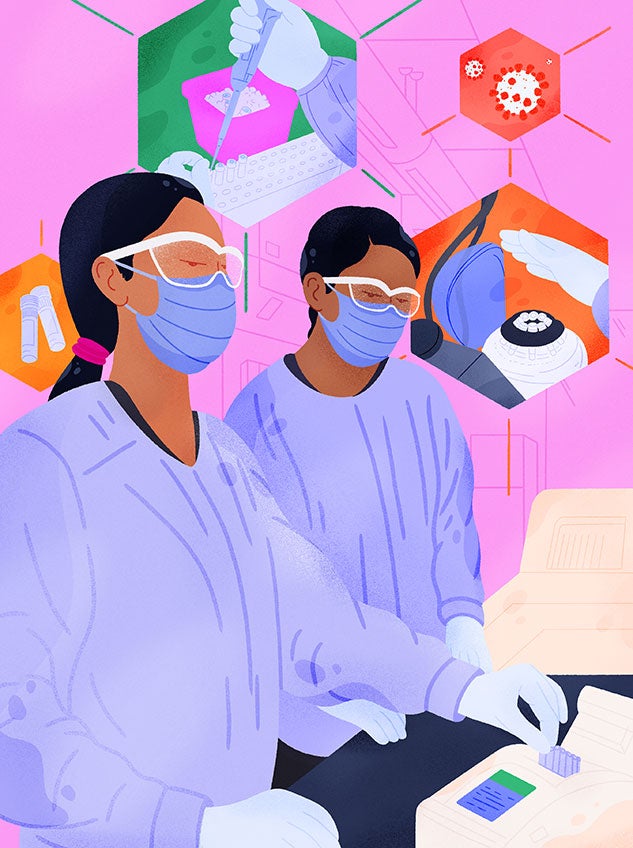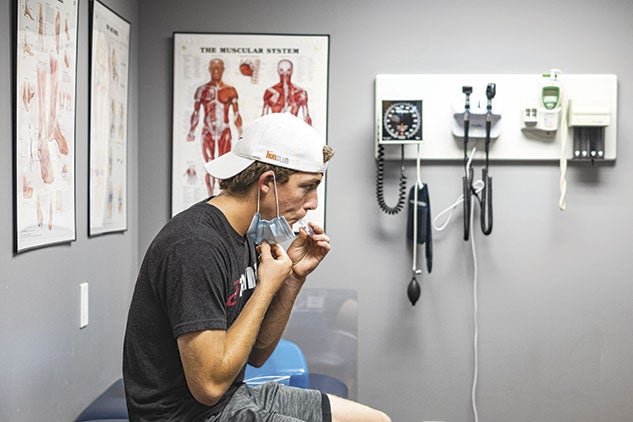A Prototyping Year Pays Off
A COVID-19 saliva test invented by Rice bioengineers paves the way for testing in low-resource settings.

On a cool evening in March, the crack of ball on bat filled the air during baseball practice at Rice’s Reckling Park. Coaches and players chattered, and an occasional fly ball escaped over the nets. And while pandemic protocols were fully in play, there was a fair amount of spitting going on near the first baseline.
Inside the Roost — in normal years, a popular concession venue for baseball fans — undergraduate and graduate research assistants were administering a new type of COVID-19 test that requires a saliva sample. Instead of swabbing nostrils, test-takers fill a plastic tube with warm saliva, seal it, then place it gingerly in a cooler. Later, the cooler full of samples will be sent to a campus lab for processing.
The saliva test uses a technology called loop-mediated isothermal amplification (LAMP) to detect fragments of genetic material from the virus that causes COVID-19. LAMP testing works in a way that’s similar to the polymerase chain reaction (PCR) technology behind the nasal swab test. (PCR tests have been in use on campus since last August.) The problem is, PCR tests are costly and more complex to process. The LAMP saliva tests are simpler, faster and more affordable, while also proving just as accurate for outbreak prevention.
Outside the Roost, sitting at a table, Rice postdoc Mary Natoli ’20 is explaining how this LAMP test came to be invented by Rice bioengineers in collaboration with researchers from the University of Texas MD Anderson Cancer Center. Researchers in the lab of Rebecca Richards-Kortum, director of the Rice 360º Institute for Global Health, along with longtime collaborator Kathleen Schmeler at MD Anderson, saw a pressing need for a COVID-19 test for use in low- and middle-income countries. They secured funding from Rice’s COVID-19 Research Fund and the U.S. Agency for International Development and went to work prototyping. By late fall, they’d begun a clinical study and were preparing to participate in Rice’s on-campus COVID-19 monitoring.

When the pandemic struck in March 2020, Natoli and Kathryn Kundrod ’20 were both finishing up their doctorates in bioengineering — Natoli’s research focused on sickle cell disease and Kundrod’s was on cervical cancer detection. Each had been drawn to Rice’s bioengineering program because of its focus on innovative translational research. “Kathryn and I both were interested in translational research; if we could be in the field implementing things, that’s what we wanted to be doing,” said Natoli. The pandemic provided just such an opportunity.
Bit by bit, Natoli, Kundrod and their teammates in the Richards-Kortum lab worked through every supply chain issue and technical challenge, coming up with innovative solutions along the way, like a heating unit made with off-the-shelf components costing about $250 to process LAMP tests. By late March, the team had completed more than 8,000 LAMP saliva tests for its clinical trial.
“Our team of students, staff and faculty has risen to the challenge of safely implementing a new testing method toward the goal of keeping our campus safe. It’s been incredible to see people’s commitment and effort to make this test work,” said Kundrod. At press time, the team had applied and was waiting for emergency use authorization from the U.S. Food and Drug Administration. — Lynn Gosnell
